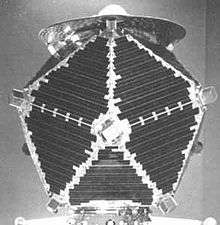Vela 1A
 Vela 1A | |
| Operator | USAF |
|---|---|
| COSPAR ID | 1963-039A |
| SATCAT no. | 00674 |
| Mission duration | 6 months (planned) |
| Spacecraft properties | |
| Manufacturer | TRW |
| Launch mass | 150 kilograms (330 lb) |
| Power | 90 W |
| Start of mission | |
| Launch date | October 17, 1963, 02:24 |
| Rocket | Atlas-LV3 Agena-D |
| Launch site | Cape Canaveral LC-13 |
| Orbital parameters | |
| Reference system | Geocentric |
| Regime | Highly Elliptical |
| Perigee | 101,081 kilometres (62,809 mi) |
| Apogee | 116,582 kilometres (72,441 mi) |
| Inclination | 38.7° |
| Period | 6,486.2 minutes |
| Epoch | October 17, 1963 |
Vela 1A (or Vela 1) was a military satellite developed to detect nuclear detonations to monitor compliance with the 1963 Partial Test Ban Treaty by the Soviet Union. It was released on October 17, 1963 from the Cape Canaveral Air Force Station, Florida, through an Atlas-Agena launch vehicle. Vela 1A was launched along with Vela 1B and with ERS 12.[1]
Vela 1A was spin-stabilized 124-kg satellite comprising the first launch in a series of six Vela launches. Together with his twin Vela 1B, their objectives were to monitor nuclear weapons explosions in space and to study x-rays, gamma-rays, neutrons, and charged particles as the satellites passed through interplanetary space, the bow shock, the magnetosheath, and the magnetotail.[2]
See also
References
This article is issued from
Wikipedia.
The text is licensed under Creative Commons - Attribution - Sharealike.
Additional terms may apply for the media files.